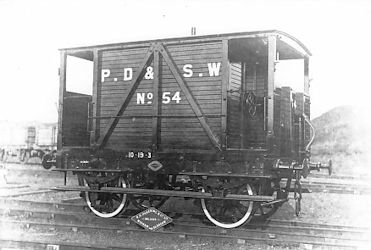|
OLD DEVONPORT
. UK |
||
|
© Brian
Moseley, Plymouth Webpage created: February 05, 2016 Webpage updated: May 07, 2021 |
||
|
RAILWAYS IN OLD DEVONPORT | MAIN LINE, LYDFORD STATION TO FRIARY STATION PLYMOUTH, DEVONPORT AND SOUTH WESTERN JUNCTION RAILWAY COMPANY Although the London and South Western Railway Company got their access to Devonport in 1876 and Plymouth in 1877, they still hankered after their own line rather than simply have running powers over the Great Western Railway. So they supported and encouraged an independent company, the Plymouth, Devonport and South Western Junction Railway Company, which received legal powers through the Plymouth, Devonport and South Western Junction Railway Act 1883 to construct a double-track main line from a junction with the LSWRC at Lydford Station to join the existing LSWR terminus at Devonport Station. The first sod was cut on the afternoon of Tuesday March 29th 1887 at the northern end of Shillamill Tunnel. Although Mr W W Szlumper, the resident engineer, and Mr Hart, the sub-contractor under Messrs Relf and Pethick, the principal contractors, were present, it was not revealed who actually performed the ceremony. No members of the public were present just the navvies who were about to start the construction work. Stations were constructed at Brentor, Tavistock, Beer Alston, Beer Ferris, Saint Budeaux for Saltash and Ford. The viaducts in Tavistock and across the Lumburn were to be eighty feet and 100 feet high respectively while the Shillamill Tunnel would be 590 yards in length. The line was officially opened on June 2nd 1890, after which trains ran into Devonport Station became a through station and trains ran as far as North Road Plymouth Station. In 1891 the line from Lipson Junction on the Great Western Railway main line to Mount Gould Junction was opened and Friary Station followed on July 1st 1891. Tamerton Foliot Station was added in 1898 and the LSWR started a suburban service between Friary and Saint Budeaux for Saltash Stations in 1906.
The Plymouth, Devonport and South Western
Junction Railway Company's brake van number 54, On June 1st 1891 the Company took possession of the East Cornwall Mineral Railway Company, who operated the line between Callington and Calstock, on the river Tamar, where wagon loads of minerals from the mines and quarries in the area were lowered to the Quayside for transhipment by river and sea all over the world. The Company had paid £48,250 in shares and £21,500 in cash for the Railway. The purchase was completed on January 4th 1894 but the Company did nothing and the legal powers it had also purchased to connect the ECMR to the Company's own main line were allowed to expire in November 1897. But yet another Company proposing yet another line from Callington to the Great Western Railway at Saltash, under the authority of the Callington Light Railway Order 1900, woke up the directors of the Plymouth, Devonport and South Western Junction Railway Company, who also applied for a Light Railway Order. This was granted in the name of the Bere Alston and Calstock Light Railway Order, on July 12th 1900, under which title the remainder of the story is related. That Railway was completed and officially opened on Monday March 2nd 1908, passenger and goods trains now running in to Bere Alston Station on the main line. Although the main line to Devonport was leased to the London and South Western Railway Company, the Callington Branch remained entirely in the hands of the owning Company, using its own rolling stock and locomotives, until it was all absorbed by the Southern Railway Company as from Monday January 1st 1923.
Click on the following links for more information about the Engines Sheds, Goods Depots and Yards, Ground Frames, Halts, Junctions, Platforms, Sidings, Signal Boxes, Signalling, Stations, Tunnels, and Viaducts -
|
||
